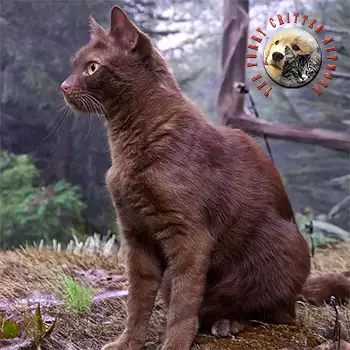Breed Standard
Head: Longer than it is wide. English version: Oriental type without whisker pinch or stop. American version: slightly triangular with significant pinch and stop. Slightly rounded skull. Jowls allowed in adult males. Long, angular muzzle. Strong, angular, firm chin.
Eyes: Large, oval, not globular, set near the bridge of the nose. Colors: all shades and intensities of green. A change in color are allowed until the age of one year.
Neck: Medium in size and length.
Body: Medium in size and bone structure. Medium-limbed (American type) or long-limbed (English type). Firm muscles.
Paw: Long, slender but not too thin. Compact, oval paws.
Tail: Moderately long, not too thick at the base, tapering toward the tip.
Coat: Short, fine, silky, lying flat against the body. Very thick undercoat. Slightly fluffier fur allowed for lilac coats. Colors: - Chocolate: chestnut brown, solid hazelnut brown. Brown whiskers and nose leather, pink paw pads. The C.F.A. recognizes this color only. - Lilac: taupe with pink highlights. T.I.C.A. recognizes both these colors. Kittens are born with tabby ghost markings that disappear during the first year.
Fault: Absence of break in the muzzle. Absence of chin. Kinked tail. Disqualify: wrong eye color. White markings.
History
Either a chestnut or lilac coat, but always green-eyed, in the early 19th century in England, a female chestnut brown cat named Granny Grump was reported. Much later, around 1880, other cats of the same color were successfully shown. In 1950, after these cats had been forgotten for a half-century, Baroness Von Ulmann crossed chocolate point Siamese cats with black European Shorthairs in an effort to obtain a foreign-type cat with a solid chocolate coat. She was so successful that breeders copied her. Unlike the F.I.Fe., the G.C.C.F. recognized the new breed in 1958 as the Chestnut Havana or Havana Brown. Since 1971, the name Havana has been preferred, perhaps in reference to the color of the cigar or to the coat color of a breed of rabbit, and also after the lilac color was accepted by some federations. Since 1960, the breed has been highly successful in the United States, although it remains rare in Europe. Recently, a cross between a Havana Brown and a serval (a large, long-legged African wildcat with a spotted coat) produced a new breed called the Savannah. It is a large, svelte cat with a spotted coat known for its gentle nature. The first arrived in France in 1998, and the S.C.F.F. has just recognized the breed.
Behavior
Havanas are lively, active, and playful but not aggressive cats. Standoffish toward strangers, they like tranquility and comfort. Calm, affectionate, and very gentle, they adore their owner. Less talkative than the Siamese, they also have a softer voice. In terms of grooming, weekly brushing is sufficient for this breed.
Health
Prone to Respiratory Infections.






